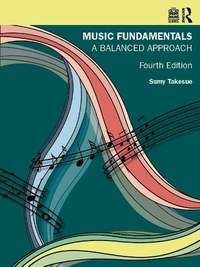
Coming soon. Music Fundamentals: A Balanced Approach
- Author: Takesue, Sumy
Book
$214.25Contents
- A Visual Tour of Music Fundamentals: A Balanced Approach
- Preface
- MODULE 1 BASICS OF PITCH
- The Musical Alphabet
- The Keyboard
- White Keys
- The Staff
- Clefs
- The G Clef (Treble Clef)
- The Octave
- Ledger Lines
- Note Reading in the G Clef
- Relating the Treble Clef to the Keyboard
- Introduction to Singing—Why Sing?
- Singing in the Treble Clef
- The F Clef (Bass Clef)
- Note Reading in the F Clef
- Relating the Bass Clef to the Keyboard
- Singing in the Bass Clef
- The Grand Staff
- Further Study of Ledger Lines
- Octave Higher (8va) or Octave Lower (8vb)
- Workbook
- MODULE 2 BASICS OF RHYTHM
- Pulse: Feeling the Beat
- Types of Rhythmic Values
- Stems and Flags
- Rhythmic Patterns with Beams
- Time Signature, Bar Line, Double Bar Line
- Meter
- Simple Meter
- Comparing a Melody in Different Meters
- Conducting Patterns
- Workbook
- MODULE 3 BASICS OF RHYTHM: EXTENDING DURATION, ANACRUSIS, RESTS
- Tied Notes: Extending Duration
- Slurs
- Dotted Notes: Extending Duration
- Fermata
- Anacrusis
- Rests
- Workbook
- MODULE 4 ACCIDENTALS
- Sharp, Flat, Natural
- Drawing Accidentals on the Staff
- Relating Accidentals on the Staff to the Keyboard
- Enharmonic Spellings
- Diatonic and Chromatic Half Steps
- Chromatic Scales
- Whole Steps
- Double Sharp, Double Flat
- Workbook
- MODULE 5 RHYTHM: SIMPLE METER EXPANDED
- Subdividing the Quarter Note
- Counting Sixteenth Note Patterns
- Syncopation
- Changing the Pulse Note in Simple Meter: The Half Note
- Changing the Pulse Note in Simple Meter: The Eighth Note
- Composing Rhythms
- Workbook
- MODULE 6 MAJOR SCALE
- What Is a Major Scale?
- Writing Major Scales: Using Tetrachords
- Writing Major Scales: Using Whole and Half Steps
- Scale Degree Names—Major Keys
- Changing the Tonic—Singing
- Transposition
- Enharmonic Scales—Major Keys
- Workbook
- MODULE 7 MAJOR SCALE KEY SIGNATURES
- Major Scale Key Signatures
- Major Scales with Sharps
- Finding the Tonic Note in a Major Scale with Sharps
- Major Scales with Flats
- Finding the Tonic Note in a Major Scale with Flats
- Circle of Fifths—Major Keys
- “Courtesy” Accidentals
- Transposition: Using a Key Signature
- Workbook
- MODULE 8 RHYTHM: COMPOUND METER
- Melodies in Compound Meter
- First Method of Counting Compound Meter
- Second Method of Counting Compound Meter
- Rests
- Beams
- Dividing the Dotted Quarter
- Comparing 6/8 and 3/4
- Two-part Rhythm Exercises
- Further Exercises in Compound Meter: Dotted Eighth Note Rhythms
- Rhythm Review—1-, 2-, 3-part Exercises
- Workbook
- MODULE 9 MINOR SCALE
- Minor Key Signatures
- Relative Major and Minor Key Signatures
- Finding the Tonic Note in a Minor Key with Sharps
- Finding the Tonic Note in a Minor Key with Flats
- Parallel Major and Minor Key Signatures
- Circle of Fifths—Minor Keys
- Three Forms of Minor Scales
- Musical Examples in the Three Forms of Minor Scales
- Comparing Pieces in Major and Minor Keys
- Scale Degree Names in Minor
- Workbook
- MODULE 10 INTERVALS
- Identifying Intervals
- Consonance and Dissonance
- Defining Quality
- Intervals of the Major Scale: Perfect and Major
- Interval Shortcuts
- Changing Major Intervals: Minor
- Changing Major and Minor Intervals: Augmented, Diminished
- Changing Perfect Intervals: Augmented, Diminished
- The Tritone
- Simple and Compound Intervals
- Descending Intervals (Interval Inversion)
- Workbook
- MODULE 11 TRIADS
- Defining and Drawing Triads
- Qualities of Diatonic Triads
- Major Triad
- Constructing Major Triads
- Harmonizing Music Using Major Triads
- Minor Triad
- Constructing Minor Triads
- Diminished Triad
- Constructing Diminished Triads
- Augmented Triad
- Constructing Augmented Triads
- Augmented and Diminished Triads Using Double Sharps and Double Flats
- Workbook
- MODULE 12 RHYTHM: COMPOUND METER EXPANDED
- Changing the Pulse Note in Compound Meter: The Dotted Half Note and Dotted Eighth
- Note
- The Triplet
- The Duplet
- Workbook
- MODULE 13 TRIADS: ROMAN NUMERALS
- Triads of the Major Scale: Use of Roman Numerals
- Primary and Secondary Triads of the Major Scale
- Harmonizing Music in a Major Key Using Roman Numerals
- Triads of the Harmonic Minor Scale: Use of Roman Numerals
- Primary and Secondary Triads of the Harmonic Minor Scale
- Harmonizing Music in a Minor Key Using Roman Numerals
- Workbook
- MODULE 14 INVERSIONS OF TRIADS
- Defining Inversions: Root Position, First Inversion, and Second Inversion
- Harmonizing Music Using Inversions
- Triads in Open and Close Position
- Figured Bass Symbols
- Constructing and Identifying Triads Using Figured Bass Symbols
- Harmonizing Music Using Roman Numerals and Figured Bass Symbols
- Drawing Chord Progressions in Close Position
- Workbook
- MODULE 15 SEVENTH CHORDS
- Qualities of Seventh Chords
- Dominant Seventh Chords
- Two Methods of Writing Dominant Seventh Chords
- Harmonizing Music in Major Keys Using Triads or Dominant Seventh Chords in Root
- Position
- Inversions of Dominant Seventh Chords
- Figured Bass Symbols for Seventh Chords
- Harmonizing Music in Major Keys Using Inverted Dominant Seventh Chords
- Chord Progressions Using Dominant Seventh Chords in Major Keys
- Dominant Seventh Chords in Minor Keys
- Workbook
- MODULE 16 FORM IN MUSIC
- Phrase Structure: Antecedent, Consequent
- Cadences: Authentic, Half, Plagal, Deceptive
- Authentic Cadence
- Half Cadence
- Plagal Cadence
- Deceptive Cadence
- Forms
- Binary Form: Two-part Form
- Ternary Form: Three-part Form
- 32-Bar Form (AABA)
- 12-Bar Blues
- Repeat Signs
- First Ending, Second Ending
- Da Capo al Fine
- Dal Segno al Fine
- Coda
- Workbook
- APPENDICES
- APPENDIX 1 Musical Terms
- APPENDIX 2 Acoustics
- APPENDIX 3 C Clefs (Alto and Tenor)
- APPENDIX 4 Modes
- APPENDIX 5 Other Seventh Chords (Major, Minor, Half Diminished, Diminished)
- APPENDIX 6 Basic Guitar Chords
- The following appendices can be found on the companion website:
- APPENDIX 7 Keyboard Exercises (Scales, Triads, and Chord Progressions)
- APPENDIX 8 Analysis of Minuet, BWV Anh. 115 (J.S. Bach)
- APPENDIX 9 Analysis of Minuet, K.2 (W.A. Mozart)
- APPENDIX 10 Analysis of Serious Moments, Op. 130, No. 23 (C. Gurlitt)
- APPENDIX 11 Analysis of Time in a Bottle (J. Croce)
- APPENDIX 12 Sansa Kroma, Akan Mmoguo Song (African playground song)
- Credits
- Track Listing
- Index



